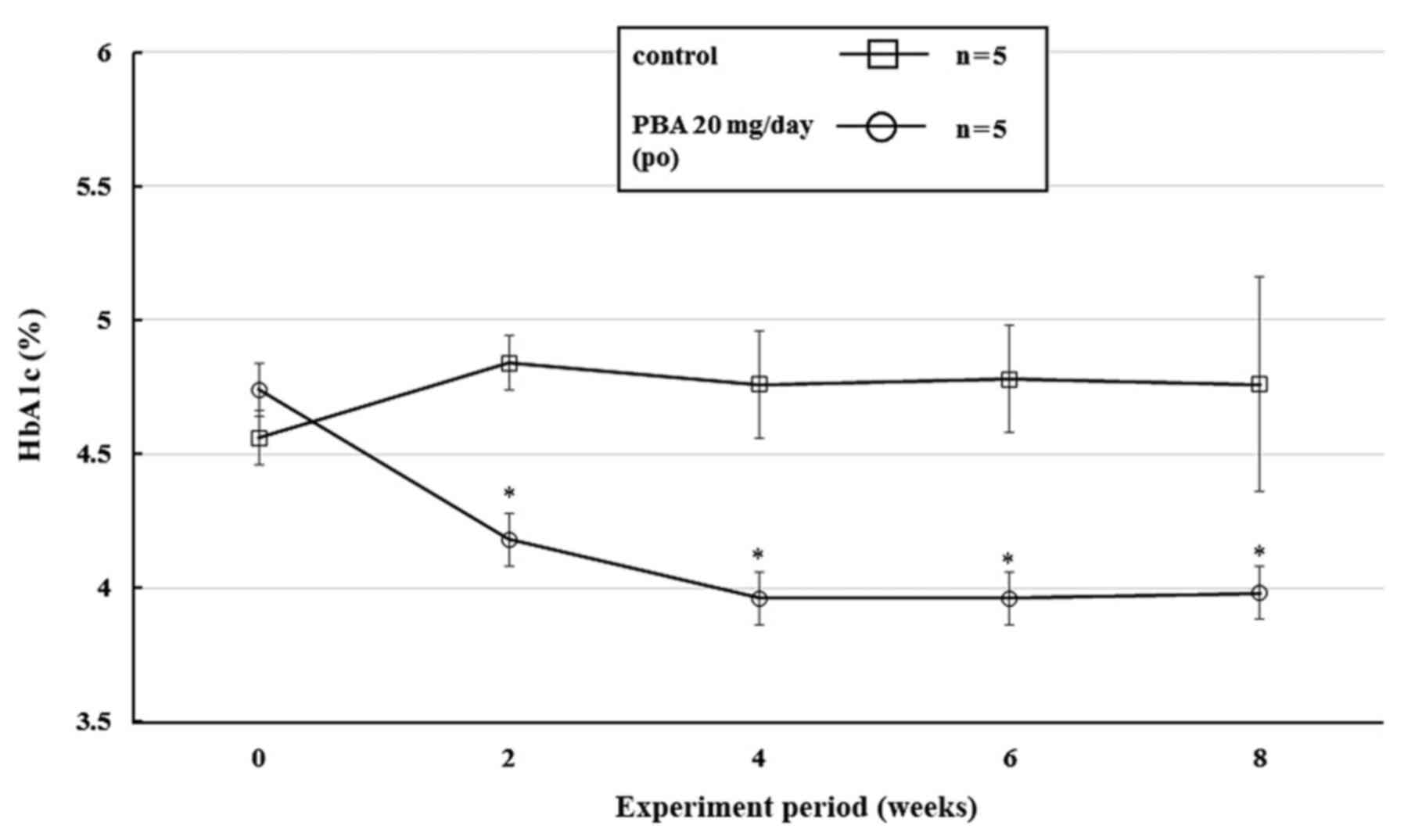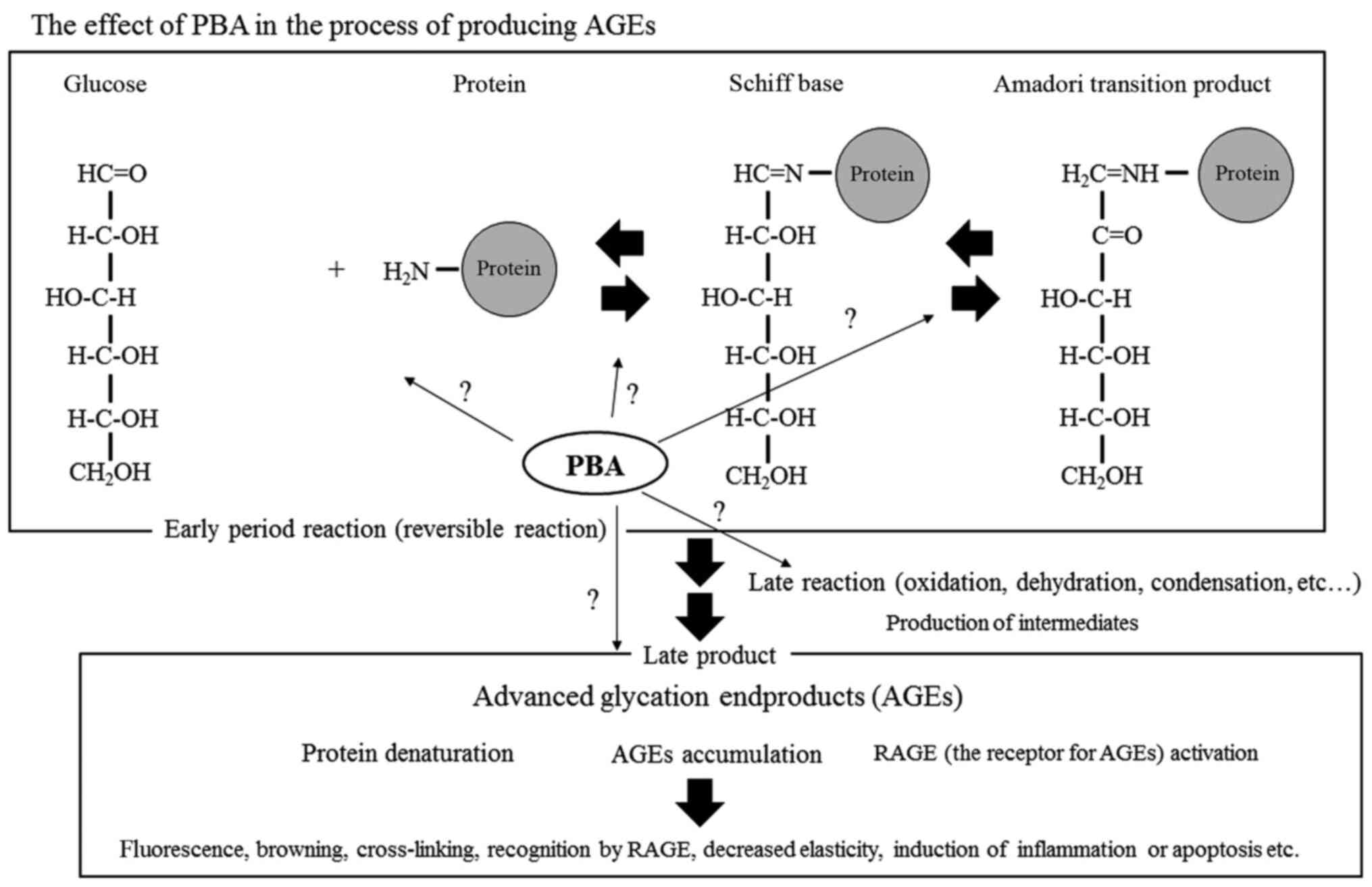|
1
|
Sadowska-Bartosz I and Bartosz G: Effect
of glycation inhibitors on aging and age-related diseases. Mech
Ageing Dev. 160:1–18. 2016.PubMed/NCBI View Article : Google Scholar
|
|
2
|
Neves D: Advanced glycation end-products:
A common pathway in diabetes and age-related erectile dysfunction.
Free Radic Res. 47 (Suppl 1):S49–S69. 2013.PubMed/NCBI View Article : Google Scholar
|
|
3
|
Rowan S, Bejarano E and Taylor A:
Mechanistic targeting of advanced glycation end-products in
age-related diseases. Biochim Biophys Acta Mol Basis Dis.
1864:3631–3643. 2018.PubMed/NCBI View Article : Google Scholar
|
|
4
|
Gautieri A, Redaelli A, Buehler MJ and
Vesentini S: Age- and diabetes-related nonenzymatic crosslinks in
collagen fibrils: candidate amino acids involved in Advanced
Glycation End-products. Matrix Biol. 34:89–95. 2014.PubMed/NCBI View Article : Google Scholar
|
|
5
|
Takata T, Sakasai-Sakai A, Ueda T and
Takeuchi M: Intracellular toxic advanced glycation end-products in
cardiomyocytes may cause cardiovascular disease. Sci Rep.
9(2121)2019.PubMed/NCBI View Article : Google Scholar
|
|
6
|
Salahuddin P, Rabbani G and Khan RH: The
role of advanced glycation end products in various types of
neurodegenerative disease: A therapeutic approach. Cell Mol Biol
Lett. 19:407–437. 2014.PubMed/NCBI View Article : Google Scholar
|
|
7
|
Prasad K and Tiwari S: Therapeutic
interventions for advanced glycation-end products and its receptor-
mediated cardiovascular disease. Curr Pharm. 23:937–943.
2017.PubMed/NCBI View Article : Google Scholar
|
|
8
|
Gasparotto J, Girardi CS, Somensi N,
Ribeiro CT, Moreira JCF, Michels M, Sonai B, Rocha M, Steckert AV,
Barichello T, et al: Receptor for advanced glycation end products
mediates sepsis-triggered amyloid-β accumulation, Tau
phosphorylation, and cognitive impairment. J Biol Chem.
293:226–244. 2018.PubMed/NCBI View Article : Google Scholar
|
|
9
|
König A, Vicente Miranda H and Outeiro TF:
Alpha-synuclein glycation and the action of anti-diabetic agents in
parkinson's disease. J Parkinsons. 8:33–43. 2018.PubMed/NCBI View Article : Google Scholar
|
|
10
|
Abul Qais F, Alam MM, Naseem I and Ahmad
I: Understanding the mechanism of non-enzymatic glycation
inhibition by cinnamic acid: An in vitro interaction and molecular
modelling study. RSC Adv. 6:65322–65337. 2016.
|
|
11
|
Iannitti T and Palmieri B: Clinical and
experimental applications of sodium phenylbutyrate. Drugs R D.
11:227–49. 2011.PubMed/NCBI View Article : Google Scholar
|
|
12
|
Kusaczuk M, Bartoszewicz M and
Cechowska-Pasko M: Phenylbutyric Acid: Simple structure-multiple
effects. Curr Pharm Des. 21:2147–2166. 2015.PubMed/NCBI View Article : Google Scholar
|
|
13
|
De Las Heras J, Aldámiz-Echevarría L,
Martínez-Chantar ML and Delgado TC: An update on the use of
benzoate, phenylacetate and phenylbutyrate ammonia scavengers for
interrogating and modifying liver nitrogen metabolism and its
implications in urea cycle disorders and liver disease. Expert Opin
Drug Metab Toxicol. 13:439–448. 2017.PubMed/NCBI View Article : Google Scholar
|
|
14
|
El-Kasaby A, Kasture A, Koban F, Hotka M,
Asjad HMM, Kubista H, Freissmuth M and Sucic S: Rescue by
4-phenylbutyrate of several misfolded creatine transporter-1
variants linked to the creatine transporter deficiency syndrome.
Neuropharmacology. 161(107572)2019.PubMed/NCBI View Article : Google Scholar
|
|
15
|
Matsufuji M, Takeshita E, Nakashima M,
Watanabe Y, Fukui K, Hanai T, Ishibashi H and Takashima S: Sodium
phenylbutyrate improved the clinical state in an adult patient with
arginase 1 deficiency. Brain Dev. 42:231–235. 2020.PubMed/NCBI View Article : Google Scholar
|
|
16
|
Khan S, Komarya SK and Jena G:
Phenylbutyrate and β-cell function: Contribution of histone
deacetylases and ER stress inhibition. Epigenomics. 9:711–720.
2017.PubMed/NCBI View Article : Google Scholar
|
|
17
|
Zeng M, Sang W, Chen S, Chen R, Zhang H,
Xue F, Li Z, Liu Y, Gong Y, Zhang H and Kong X: 4-PBA inhibits
LPS-induced inflammation through regulating ER stress and autophagy
in acute lung injury models. Toxicol Lett. 271:26–37.
2017.PubMed/NCBI View Article : Google Scholar
|
|
18
|
Wang X, Zhang M, Jiang N and Zhang A:
Sodium Phenylbutyrate ameliorates inflammatory response induced by
staphylococcus aureus lipoteichoic acid via suppressing
TLR2/NF-κB/NLRP3 Pathways in MAC-T Cells. Molecules.
23(3056)2018.PubMed/NCBI View Article : Google Scholar
|
|
19
|
Ono K, Ikemoto M, Kawarabayashi T, Ikeda
M, Nishinakagawa T, Hosokawa M, Shoji M, Takahashi M and Nakashima
M: A chemical chaperone, sodium 4-phenylbutyric acid, attenuates
the pathogenic potency in human alpha-synuclein A30P + A53T
transgenic mice. Parkinsonism Relat Disord. 15:649–654.
2009.PubMed/NCBI View Article : Google Scholar
|
|
20
|
Ono K, Nimura S, Nishinakagawa T,
Hideshima Y, Enjyoji M, Nabeshima K and Nakashima M: Sodium
4-phenylbutyrate suppresses the development of dextran sulfate
sodium-induced colitis in mice. Exp Ther Med. 7:573–578.
2014.PubMed/NCBI View Article : Google Scholar
|
|
21
|
Ono K, Nimura S, Hideshima Y, Nabeshima K
and Nakashima M: Orally administered sodium 4-phenylbutyrate
suppresses the development of dextran sulfate sodium-induced
colitis in mice. Exp Ther Med. 14:5485–5490. 2017.PubMed/NCBI View Article : Google Scholar
|
|
22
|
Pomozi V, Brampton C, Szeri F, Dedinszki
D, Kozák E, van de Wetering K, Hopkins H, Martin L, Váradi A and Le
Saux O: Functional rescue of ABCC6 deficiency by 4-phenylbutyrate
therapy reduces dystrophic calcification in Abcc6-/- Mice. J Invest
Dermatol. 137:595–602. 2017.PubMed/NCBI View Article : Google Scholar
|
|
23
|
Hori M, Yagi M, Nomoto K, Ichijo Ryo,
Shimode A, Kitano T and Yonei Y: Experimental models for advanced
glycation end product formation using albumin, collagen, elastin,
keratin and proteoglycan. Anti-Aging Med. 9:125–134. 2012.
|
|
24
|
Yagi M and Yonei Y: Glycative stress and
anti-aging 4. The evaluation of glycative Stress: Evaluation for
anti-glycative effect. Glycative Stress Res. 4:87–92. 2017.
|
|
25
|
Enokida T, Yamasaki K, Okamoto Y, Taguchi
K, Ishiguro T, Maruyama T, Seo H and Otagiri M: Tyrosine411 and
Arginine410 of human serum albumin play an important role in the
binding of Sodium 4-Phenylbutyrate to Site II. J Pharm Sci.
105:1987–1994. 2016.PubMed/NCBI View Article : Google Scholar
|
|
26
|
Yamasaki K, Enokida T, Taguchi K, Miyamura
S, Kawai A, Miyamoto S, Maruyama T, Seo H and Otagiri M: Species
differences in the binding of sodium 4-phenylbutyrate to serum
albumin. J Pharm Sci. 106:2860–2867. 2017.PubMed/NCBI View Article : Google Scholar
|
|
27
|
Ikeda H: KK mouse. Diabetes Res Clin
Pract. 24 (Suppl):S313–S316. 1994.PubMed/NCBI View Article : Google Scholar
|
|
28
|
Sato A: Indicators of glycemic
control-hemoglobin A1c (HbA1c), glycated albumin (GA), and
1,5-anhydroglucitol (1,5-AG). Rinsho Byori. 62:45–52.
2014.PubMed/NCBI(In Japanese).
|















